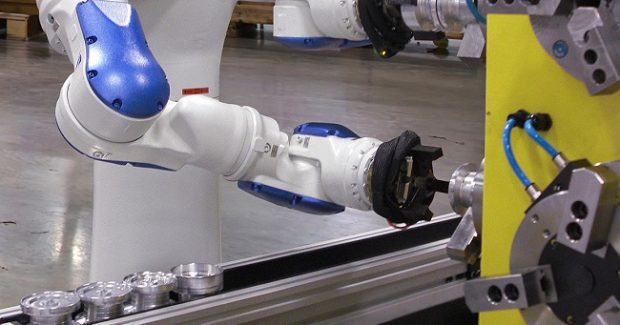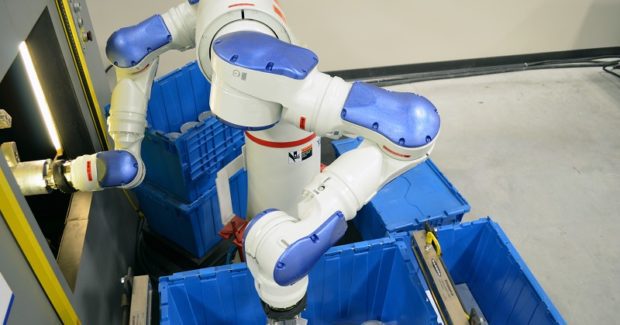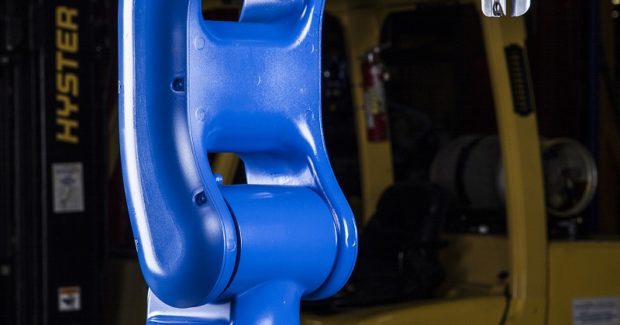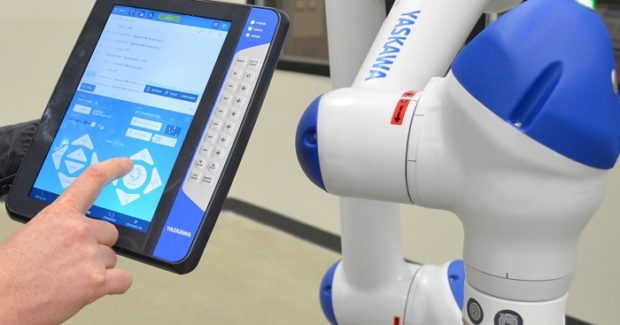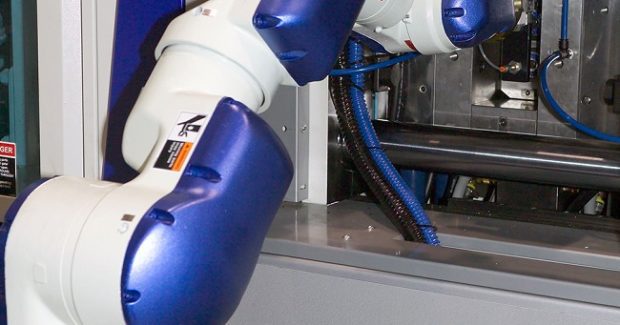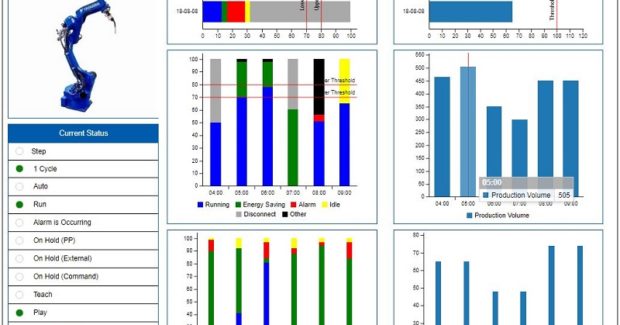Finding Balance: Robotic Machine Tending Tips
Robotic automation of machine tending can add value to operations in more ways than one. By considering these concepts and combining best practices with high performance robots and peripherals, operational inefficiencies will diminish, paving the way for a more productive future.
Posted: June 28, 2019
From greater machine utilization to lower operational costs, robotic machine tending systems reliably deliver productivity gains for a wide variety of applications, including boring, milling and grinding. With the trend of high-mix, low volume production for small to medium-size manufacturers on the rise, shops are taking a serious look at robotic automation to meet customer demands. Finding balance amid the vast combination of cutting-edge robots and technologies, however, requires that they consider the following concepts:
INDUSTRIAL ROBOTS
Extremely fast, space-saving and maneuverable industrial robots designed for easy installation, operation and maintenance are growing in popularity, delivering drastically increased uptime and game-changing results to manufacturers of all sizes. Design enhancements like higher IP wrist ratings to allow for protection from cutting fluids, and higher moment and inertia ratings for superior performance in large part handling, are helping overcome pain points. Another budding trend is the use of small and lightweight six-axis robots. Capable of supporting a unique variety of tooling and sensors to fulfill diverse machine tending needs, these robots enable mounting close to workpieces and other machinery in existing lines or cells. Ideal for extracting a machined part out of a chuck or for loading small press brakes, effective use of these extremely fast robots can substantially reduce cycle times.
HUMAN-ROBOT COLLABORATION
Highly versatile and portable collaborative robots (cobots) can greatly enhance production operations. Optimized for safety and designed to work with or near human workers potentially without a hard safety enclosure, cobots can now be programmed by novice users to perform a broad range of tasks, especially for smaller batches. They are well suited for fast deployment and redeployment on demand. With the shift from centralized manufacturing to distributed manufacturing systems (DMS), cobots are gaining popularity because they enable greater flexibility in production processes while lowering supply chain costs. Complicated end-user demands also put a premium on valuable factory floorspace, giving shops another reason to start using collaborative automation that can function with limited safety components based on a risk assessment.
TRANSFORMATIVE TECHNOLOGY
Robot OEMs continually develop revolutionary technologies to deliver better efficiency, quality and consistency. Industry 4.0 greatly facilitates this innovation, fueling a higher level of production efficiency. Some of the latest components to consider are:
- Lightweight Intuitive Teach Pendants. Newer standard teach pendants are ergonomically designed to reduce programming fatigue and offer intuitive graphical interfaces with touchscreens for user-friendly programming. Engineered with multiple user levels for varying skill sets and unique display options for specific applications, these pendants include a number of convenient features. Due to their ease-of-use factor, intelligent tablet-based teach pendants take industrial and collaborative robot programming to the next level. Designed using advanced leading Human Machine Interface (HMI) features, intelligent pendants are integrated with tools that make robot programming more intuitive and easier to use. From a “click and program” approach that guides the robot via familiar programming commands to built-in Smart Frame technology that simplifies user frame issues, robot jogging is now simple for robot programmers of all skill levels.
- Simple Machine Tool Interfaces. For maximum safety and optimal cycle time, it is vital for a machine tool to communicate well with the robot and vice versa. Machine signals indicating important information, such as “door is open,” “vice is closed,” or “part is in place,” keep the robot in the know and on task. While it is possible for some robots to be interfaced directly into a machine tool via a factory interface option, most must be configured with a communication interface like EtherNet I/P. Similar to standard office EtherNet, EtherNet I/P uses the same type of TCP and I/P messaging, but has an application layer where the data is arranged in objects. By using standardization software such as this, the integration process is eased and safety increases due to the reduction of robot control wiring required.
VERSATILE WORKCELL OPTIONS
Many small and medium-size manufacturers in high-mix, low volume production environments lose valuable time by stopping equipment to swap out components. The ideal solution for these job shops would be an easy-to-load, straightforward system with flexible options. Multiple robot system integrators have created pre-engineered robotic machine tending systems to ensure timely and reliable part loading and unloading. These off-the-shelf kits offer step-by-step setup and user-friendly interfaces to facilitate quick utilization. Technology advancements and new approaches in 3D vision greatly enhance the robotic handling of a broad and varied mix of parts. From loading and unloading to handling randomly-presented parts, there are many pre-engineered options shops can choose from to overcome costly bottlenecks, as well as custom systems for unique production environments.
WORKFLOW ERGONOMICS
As end-user demands become more complicated, shops may need to rethink application processes and workspace layouts to boost production. From feeding piece parts for fabrication to preparing and transferring the final product for shipping, there is a lot to coordinate. Where a robot is concerned, it is vital that all the parts being fed are accessible by the robot. Conversely, the application process should not hinder other aspects of the production facility:
- Part Ordering/Racking. If a robot needs to grab a raw part, localization is needed so that the part can be retrieved correctly. The trick here is to find the balance between convenience and flexibility. A classified racking system is a relatively simple option that is ideal for use on the same type of part over a long period of time. For more flexibility, vision systems may be a better option.
- Gripper Design. One of the most complicated aspects of machine tending is how the robot will grasp the part. This process requires selection of the right robot/end-of-arm tool (EOAT) combination, which can be electric, pneumatic, vacuum and, in some cases, hydraulic. That said, the best advice is to keep it safe and simple. If a robot is dedicated to a single part, a simple gripper will most likely do. However, high-mix production may dictate a more flexible gripper that can adapt to changing application requirements. Items like gripper payload, speed, accuracy and grip force should be considered, as well as part shape and surface texture. A thorough engineering study for any application is necessary to determine the proper end effector for the job.
- Speed vs. Precision. It is important for the speed of the robot to be adequate to complete each stage of the production process in such a way that high-quality parts are the result. While motions near and outside of a machine can be executed relatively quickly, movements surrounding part gripping and insertion require more precision and demand slower robot speeds.
- Work Holding Fixtures. The fixture or chuck inside a machine must be accurate and precisely adjusted to the parts being machined. Most fixtures or chucks are equipped with pneumatic or hydraulic systems that keep the part in place during the machining process.
- Software. Many software programs are available to enhance various aspects of production. From programming tools that specifically work to optimize machine tending operations to software platforms that are extensible for managing networked production environments, there are other aspects to consider outside of choosing the best hardware for the job.
- Training. Installing a robotic system is a key step to enhancing operations, but more important than the system itself is having a knowledgeable workforce to help manage successful robot implementation and utilization. Many factories today accelerate ROI by creating robotic workcell champions: employees fully dedicated to robot programming and utilization. Ideally, they are trained and certified by the robot manufacturer before equipment installation to facilitate a smooth implementation process and minimize production downtime.
Robotic automation of machine tending can add value to operations in more ways than one. When manufacturers consider these concepts and combine best practices with high performance robots and peripherals, operational inefficiencies diminish, paving the way for a more productive future.



